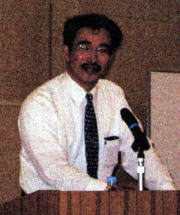No.196-2
| UNESCO, World Terakoya Movement. Report of Miswritten Postcards Campaign
2002. |
In 2002, Meguro UNESCO Association could donate 200 thousands yen to the following Nepalese "Lumbini Projects" from the profits of miswritten postcards which could be turned into cash. Thank you for your cooperation.
The total number of cards gathered with your cooperation is shown below.
Collected miswritten postcards
Elementary schools in Meguro ward 21 of 22 schools 1,964pieces
Junior high schools in Meguro ward 7 of 12 schools 270pieces
Officials and centers in Meguro ward
1,293pieces
People in Meguro ward and Meguro UNESCO Association members 1,206pieces
Unused stamps and telephone cards Total Amount of 62,453yen
Donation by cash
8,373yen
|
Collected cards from elementary and junior high schools are sent to the National Federation of UNESCO Associations in Japan. Others are converted into cash by Meguro UNESCO Association and sent to support countries as a part of funds for the UNESCO World Terakoya Movement.
Since the new head office started functioning last October, lots of neighbors and non-members bring the miswritten cards and donations to the office. We appreciate the kindness of those people. Please continue to cooperate in this campaign.
 Recruit volunteer staff
Recruit volunteer staff
Volunteers are needed to ask your neighboring schools and institutions to gather miswritten postcards.
After the campaign in 2002, we continue to gather miswritten postcards, though we cannot accept used telephone cards and stamps.
ASHIDA and HONJO: International Support Activity
UNESCO Cultural Lecture "Japan's Policy on International Educational Support and Aid"
|
Lecturer: Takao Kamibeppu, professor at Tokyo Jogakkan College Date & Time: March 24, 2003 (Mon.) 6:30-8:30pm
Place: Nakameguro GT Plaza Hall
While working for the Ministry of Education, Science and Culture, Mr. Kamibeppu was engaged in the educational development project in developing countries through Bangkok UNESCO Association. After retiring, he studied abroad in the United States and is currently teaching a course on educational support in developing countries at Jogakkan College. In the first part of the lecture, he explained how the Japanese central government constituted the support and aid policy on international education by describing the deliberative assembly process and providing concrete details of the aid. He followed with an explanation about the process of forming and conciliating the policy during the years from 1970 to 2000. The following is a summary of his explanation.
The International Education Support and Aid Plan was introduced by the ex-prime minister Sato and materialized from the administrative vice-minister's personal round-table discussion based on the report submitted by the advisory body in 1970. This plan arose as a resolution to the criticism of storing surplus money accumulated from the bubble economy and as a measure to solve North-South problems emerging as a result of the increasing numbers of developing countries accompanying their independence from colonization. Up until 1990, the educational support provided by the Japanese ODA (government aid) was actually operated by two major ministries with different objectives. The Ministry of Foreign Affairs and related ministries such as International Trade and Industry, and Labor created JICA (international aid organization) in 1974 on one hand and the Ministry of Education, Science and Culture operating their own support program on the other. The Ministry of Foreign Affairs and JICA were interested in providing the hardware (constructing schools and assigning teachers), whereas the Ministry of Education, Science and Culture placed their importance on the exchange student and UNESCO programs. Furthermore, the Ministry of Foreign Affairs recognized education as a part of the diplomatic program, whereas the Ministry of Education, Science and Culture recognized education as education itself.
However after 1993, the research committees and discussion groups were organized separately within JICA and Ministry of Education, Science and Culture (Ministry of Culture), and the two government project teams are currently working jointly under a cooperative policy. The reason being that the provision of educational aid cannot be executed effectively without theeducational know-how of the Ministry of Education, Science and Culture nor the technical skill for foreign aid of the Ministry of Foreign Affairs.
Currently, the Japanese educational system, experience and knowledge are being offered through the International Educational Support and Aid program, however, provisions should be made to offer suitable educational support based on the needs and environmental situation of the recipients.
Following Mr. Kamibeppu's lecture, several questions were raised and discussions took place. Our advisors, Mr. Tajima and Mr. Sasaoka attending the lecture, provided supplemental explanation on the deliberative assembly and situation of the universities based on their actual experiences.
Their contribution was extremely valuable in deepening our understanding of the lecture. As a private organization promoting World Terakoya Movement, the lecture was of great interest for all of us.
Photo: Mr. Kamibeppu
Reported by: Tadashi Nakamura, Training Program Committee member
to next page
 Recruit volunteer staff
Recruit volunteer staff
 Recruit volunteer staff
Recruit volunteer staff
